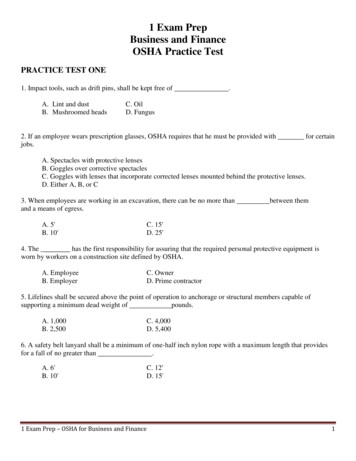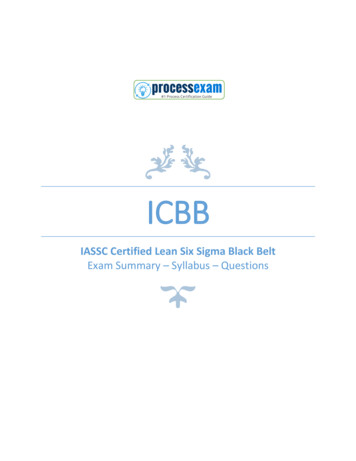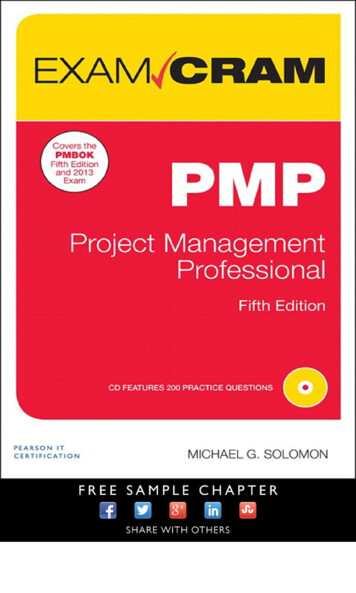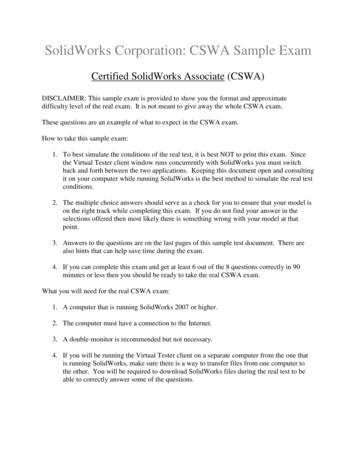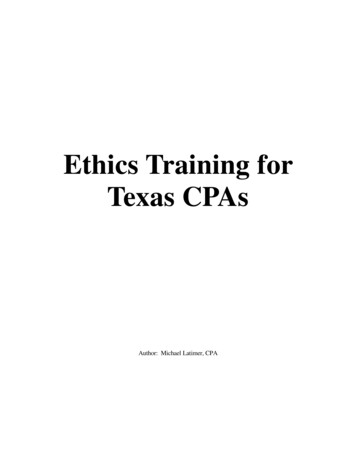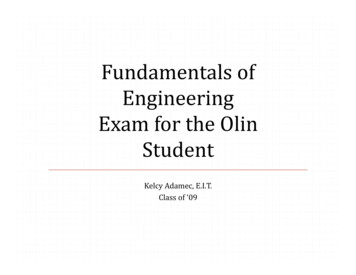
Transcription
AP World History Practice ExamSection I: Multiple-Choice QuestionsInstructions (Based on those given on the actual AP World History Exam)Section I of this exam contains 70 multiple-choice questions.Mark all of your answers on the answer sheet included in the booklet. It is important to note that while you may write on the test itself,answers must be transferred to the answer document in the time allowed.Nothing written in the test booklet will be graded.After you have decided which of the suggested answers is best, completely fill in the corresponding oval on the answer sheet. Give only oneanswer to each question. If you change an answer, be sure that the previous mark is erased completely. Here is a sample question and answer.Sample QueStionJapan is aA.state.B.city.C.country.D. continent.Sample anSwerABD
2AP World HIStoryUse your time effectively, working as quickly as you can without losing accuracy. Do not spend too much time on any one question. Goon to the other questions and, if you have time, come back to the onesyou have not answered. It is not expected that everyone will know theanswers to all of the multiple-choice questions.About GueSSInGEach correct answer earns a point. There is no penalty for guessing; thisis a change from previous years. You should mark the best answer youhave for each question.
AP World HIStory PrACtICe eXAM3WORLD HISTORYSECTION ITime—55 minutes70 QuestionsDirections: Each of the questions or incomplete statements belowis followed by five suggested answers or completions. Select the onethat is best in each case and then fill in the corresponding oval on theanswer sheet.Note: This exam uses the chronological designations BCE (before thecommon era) and CE (common era). These labels correspond to BC(before Christ) and AD (anno Domini), which are used in some worldhistory textbooks.1.For what period would archaeologists first begin to find permanenthuman settlements?A.The PaleolithicB.The Classical EraC.The Bronze AgeD. The Neolithic2.Identify the statement that best begins an explanation of theNeolithic Revolution.A.In Northern Europe, nomadic hunters began to produce morecomplex stone tools.B.In East Asia, early settlers began using markings on turtle shellsand bones as an early form of record keeping.C.In the Middle East, people began to settle in small communities and practice agriculture.D. In Mesoamerica, agricultural settlements saw an expansionof their populations and the beginning of more complexgovernments.
4AP World HIStoryMore reliable and abundant food supplyJob specialization based on a surplus of fooddevelopment of a more formal social hierarchyIncreased population creating some social pressures as traditional family/clanloyalties broke down3.All of the above resulted from what cultural change?A.The development of complex governmentB.The adoption of agricultureC.The development of metal toolsD. The growth of complex, organized religion4.Which of the following civilizations shares the most in commonwith the Harappan civilization found in the Indus River Valley?A.The Mogul Empire in IndiaB.The Tokugawa Shogunate in JapanC.The Olmec civilization in MesoamericaD. The Athenian city-state in ancient Greece5.Identify the important original contribution of the Hebrew cultureto the civilizations in the Middle East and Mediterranean during theClassical Period.A.MonotheismB.Written legal codeC.Phonetic alphabetD. Priest caste
AP World HIStory PrACtICe eXAM5INDUSVALLEY6.Identify the sacred text that originated in the area shaded aboveafter the migration of the Aryan people from Central Asia, shownby the arrow on the map.A.TorahB.The AnalectsC.VedasD. The Book of the Dead7.Confucianism established political and social systems in China whilewhat other philosophy contributed significantly to China’s medicalpractices and art and architecture?A.LegalismB.ShintoismC.HinduismD. Daoism
68.AP World HIStoryIn addition to Judaism, identify the two cultures that most influenced the development of early Christianity.A.Sumerian and EgyptianB.Greek and RomanC.Egyptian and GreekD. Sumerian and Roman9.What statement best explains the presence of Greek architecturalstyles throughout the Middle East and the Mediterranean?A.Greek trading empires and the conquests of Alexander theGreat spread Hellenic culture across these areas.B.The Romans adopted Hellenic culture and then spread it to allparts of the empire.C.The Persian conquest of the Greek city-states allowed forGreek culture to spread into its empire.D. The decline of pre-Classical civilizations made Greek culturethe most attractive to people living in these regions.10. What civilization was initially responsible for the unification of theMiddle East, Asia Minor (modern Turkey), and the Iranian plateau?A.RomeB.EgyptC.OttomanD. Persian
AP World HIStory PrACtICe eXAM711. What statement accurately compares the government of the Handynasty with that of the Roman Republic?A.Power in the Han dynasty was concentrated in a centralizedbureaucracy dominated by Confucian scholars while power inthe Roman Republic was shared among the major landowningfamilies of Rome.B.Power in the Han dynasty rested solely with the emperor whilein Rome all citizens were able to express their opinions andinfluence government.C.Power in the Han dynasty was concentrated in a centralizedbureaucracy dominated by Confucian scholars while in theRoman Republic all citizens shared power in governmentaldecisions.D. Power in the Han dynasty rested in the hands of the militarygenerals and their successors, who had helped defeat the previous Qin dynasty, while power in the Roman Republic rested inthe hands of legion commanders and provincial governors.12. What statement defines the dynastic cycle?A.Chinese governments ruled based on the power of a singlefamily.B.While at first militarily powerful, as a dynasty came to dependmore on Confucian scholars than generals, it became weakermilitarily and would eventually fall to foreign invasion.C.Chinese government depended upon economic growth to sustain power, and as the economy declined, based on cycles, sotoo did the dynasties.D. Initially a Chinese government enjoyed prosperity and economic growth, but over time corruption, internal disasters, andexternal invasions all eroded a dynasty’s power.
8AP World HIStory13. What statement best explains the changes in the Roman legionsafter about 200 CE?A.The legions stopped using the traditional phalanx formationthat was developed by Greek warriors and instead began tofight with more open lines and swords instead of spears.B.The legions no longer protected the Roman frontier as theyturned to looting the wealthy provinces of Italy and Greece.C.The legions became more dependent on foreign recruits, especially Germans, as fewer Romans volunteered for military service.D. The legions became more devoted to individual commandersand not to the Senate and people of Rome.14. What statement offers the most complete analysis of the decline ofthe Han dynasty?A.Migrations of Germanic people from the north; lack of citizenparticipation in government; unemployment due to excessivenumbers of slaves.B.Attacks by militarily superior horse-mounted steppe tribesmenequipped with strong bows; regional political rivalries takingadvantage of a weak central government; diseases/plagues devastating the populations of major cities.C.Attacks by militarily superior horse-mounted steppe tribesmenequipped with strong bows; internal revolts due to increasedtaxes and weakening central authority; weak emperors and corrupt bureaucracy.D. Disruption of trade networks by well-equipped tribesmenfrom the steppes; exhaustion of local agricultural lands due tooverfarming; decline in the available number of slaves due tomilitary defeats and slave revolts.
AP World HIStory PrACtICe eXAM915. Identify the major trade network between Asia and Europe.A.Trans-Saharan caravansB.The Silk RoadC.Indian Ocean sea-lanesD. Mediterranean sea-lanes16. In the eighth century CE, identify the city that became the centerof trade along the Silk Road.A.VeniceB.TimbuktuC.CalicutD. Baghdad“Thus says the Lord, the God of Israel, ‘Let my people go, thatthey may hold a feast to me in the wilderness.’”— Moses’s words to Pharaoh asrecounted in the Bible, Exodus 5:117. Identify which of the following religions that would NOT acceptthe statement above as part of their religious heritage.A.Roman CatholicismB.IslamC.Eastern OrthodoxD. Zoroastrianism
10AP World HIStory18. Though often not officially interested in foreign trade, what example below indicates the involvement of the Chinese government ininternal trade?A.The Great Wall of ChinaB.The opening of the civil service exam to all backgroundsC.The construction of the Grand CanalD. The use of tax money for flood control19. Which of the following is a correct analysis of the impact of theearly Mongol Empire on trade?A.The Mongols looted caravans to the point that the Silk Road nolonger facilitated trade across Asia.B.The Mongols patrolled trade routes and protected caravans intheir empire, leading to a boom in trade along the Silk Road.C.Merchants sought other routes, especially through SoutheastAsia and the Indian Ocean, to avoid the Mongol tribesmen.D. Merchants were forced to turn to other professions as the Mongolsrefused to allow other peoples to move through their empire.
AP World HIStory PrACtICe eXAM1120. The image above is an indication of the growing influence of whatculture in India?A.PersianB.BuddhistC.ChineseD. Islamic21. What statement best explains the adoption of the Arabic languageacross North Africa?A.The retreat of the Roman Empire allowed people to return totheir native language.B.The Islamic conquest destroyed the native population living inthis region.C.The Islamic conquest of the region resulted in many conversions to Islam and the adoption of Islamic customs.D. The defeat of the Byzantine Empire convinced many inhabitants of the superiority of Arabic culture.
12AP World HIStory22. What statement explains the origins of Swahili culture?A.Bantu peoples moving into southern Africa pushed manygroups toward the India seacoast, where they were forced toadopt local customs.B.Bantu peoples moving into southern Africa traded with Arabsalong the east coast, creating a blended culture.C.Arab merchants dominated trade along the African coast, forcing their culture on the small and weak local city-states.D. Arab merchants inhabited the coastal regions of East Africa butwere forced to change their agrarian and trade customs to fitthe local climate.23. In many Southeast Asian trade cities, diasporic communitiesfrom this culture played a very important role in the local economy and politics.A.IndianB.Greek/HellenicC.JapaneseD. ChineseHe [Kublai Khan] makes them take of the bark of a certaintree. What they take is a certain fine white skin which liesbetween the wood of the tree and the thick outer bark, andthis they make into something resembling sheets of paper, butblack. When these sheets have been prepared they are cutup into pieces of different sizes. The smallest of these sizesis worth a half tornesel; the next, a little larger, one tornesel;one, a little larger still, is worth half a silver groat of Venice;another a whole groat; others yet two groats, five groats, andten groats and on every piece a variety of officials, whose
AP World HIStory PrACtICe eXAM13duty it is, have to write their names, and to put their seals.And when all is prepared duly, the chief officer deputed bythe Khan smears the seal entrusted to him with vermilion,and impresses it on the paper, so that the form of the sealremains printed upon it in red; the money is then authentic.Anyone forging it would be punished with death. And theKhan causes every year to be made such a vast quantity ofthis money, which costs him nothing, that it must equal inamount all the treasure in the world.— From The Travels of Marco Polo24. What statement best evaluates Marco Polo’s discussion of papermoney from the perspective of a modern economist?A.Absolute authority allowed for the printing of unlimitedamounts of currency without inflation.B.Marco Polo failed to understand how the khan collects wealthin order to print the currency without rampant inflation.C.Due to lack of foreign trade, the printing of currency by thekhan does not increase inflation because no foreign wealthenters the Chinese economy.D. As long as a national government—the khan in this case—istrusted by its people, the government can print currency without fear of inflation.25. The influence of Islam in Southeast Asia is an example ofA.imperialism.B.migration.C.cultural diffusion.D. ethnocentrism.
14AP World HIStory26. What statement best explains how Greek and Roman learning waspreserved during the Middle Ages in Europe?A.Monasteries saw it as their mission to copy all of the older textsof the Greek and Roman philosophers.B.The works of Greek and Roman philosophers were preservedby both the Byzantine and the Islamic civilizations.C.The Roman Catholic Church maintained extensive libraries ofGreek and Roman works throughout Europe.D. The collapse in Western Europe was not so great as to cause ashutdown of universities at the major population centers.27. Identify the major source of instability across Asia and Europe during the fourteenth century.A.Steppe tribesmenB.The Black DeathC.The Islamic caliphD. Famine28. What statement explains the bureaucratic view of Buddhism duringthe Tang dynasty?A.Buddhism provided the society with a means of appeasing thepoorer peasant classes because, unlike Confucianism, it wasegalitarian.B.Buddhism was a threat to the power of the Confucian bureaucracy because it offered an alternative social organization.C.Buddhism was not recognized as an issue for the bureaucracybecause it was a religion that did not address political issues.D. Buddhism was seen as a challenge to the Confucian religiousbeliefs held by many in the bureaucracy.
AP World HIStory PrACtICe eXAM1529. How did the caravel alter European society in the fifteenth century?A.It allowed for more accurate navigation.B.It gave the European powers a strong military advantage overtheir chief rivals, the Ottoman Empire.C.It allowed for long-distance ocean travel.D. It provided Europeans with a means of challenging Islamicpower in the Mediterranean.30. Identify the nation that led European exploration through government efforts to provide their sailors with the most advanced navigation instruments and techniques available.A.SpainB.FranceC.PortugalD. Great Britain31. What allowed Britain and France to benefit from Spain’s silver mining in Latin America?A.Both nations manufactured goods for sale to Spain, which didnot develop a strong manufacturing sector.B.Britain used military resources to take Spanish colonies whileFrance’s royal family inherited the Spanish throne throughmarriage.C.Britain used military resources to take Spanish colonies whileFrance provided Spain with manufactured goods.D. Both of these nations used military force to seize colonies in thesilver-producingare as.
16AP World HIStory32. In the sixteenth and seventeenth centuries, what fueled the increasein global trade?A.The export of cheap labor in the form of slaves from AfricaB.The active participation of the Chinese government in expanding tradeC.The massive amounts of silver made available from New WorldminesD. The influx of New World cash crops like sugar and tobacco33. What statement best compares the results of the ColumbianExchange in Europe and China?A.Both areas saw population increases and economic growthfueled by New World silver.B.While Europe saw great economic growth, the Chinese economy failed to benefit from new wealth and suffered due topopulation growth caused by the New World crops.C.Europe benefited economically from New World silver whilethere was almost no impact in China.D. Europe’s economy failed to grow because most New Worldsilver went to China to purchase luxury trade goods like porcelain and silk.
AP World HIStory PrACtICe eXAM1734. What statement best compares agricultural changes in the New andthe Old Worlds due to the Columbian Exchange?A.In the New World, the importation of new grain crops provided a boost to world food production while exotic crops liketomatoes had little impact on Old World agriculture.B.In the New World, cash crops like sugar became the key agricultural product while potatoes and corn contributed to increasedfood production in the Old World.C.In the New World, little agricultural change occurred becausethe native population was devastated by disease; however,potatoes and corn contributed to population growth in Europeand China.D. In the New World, both food production and cash crop production grew rapidly while the Old World experienced littleagricultural changes.35. What identifies one result of cash crop production in the ationD. Famine36. The spread of Islam into India and Southeast Asia was facilitated byA.the military conquest of the caliphate.B.the introduction of Sufi mysticism.C.the lack of native belief systems.D. the Mongol conquest.
18AP World HIStory37. The creation of the Atlantic trade network greatly facilitated thespread of what religion?A.IslamB.SikhismC.AnimismD. Christianity38. The Renaissance resulted from economic growth in Europe, but itwas most recognized forA.the creation of political systems dominated by the middle class.B.innovations in visual and performing arts.C.the establishment of global empires by the European powers.D. the elimination of the aristocracy as the elite class of theEuropean social system.39. What was the purpose of the encomienda system in the Spanishcolonies of the New World?A.Provide an incentive for Spanish settlers to immigrate to theNew WorldB.Allow for the creation of independent states allied with theSpanish CrownC.Provide labor for the creation of Spanish plantations, ranches,and miningD. Facilitate the conversion of the native population to RomanCatholicism
AP World HIStory PrACtICe eXAM1940. What social class developed in the Spanish colonies of the NewWorld that had the ability to amass economic wealth but could notachieve political power?A.MestizosB.CreolesC.MulattosD. Peninsulares41. What was the purpose of the European monarchs in claiming rulethrough the divine right of kings?A.To reinforce the power of the church over secular rulersB.To establish a stronger connection between church and stateC.To strengthen a king’s claim to absolute power over his subjectsD. To allow the nobility to use the king as a symbol of centralpolitical authority without actually giving the king this greatpower42. What European nation established the largest land-based empire bythe mid-eighteenth century?A.Great BritainB.FranceC.Austria-HungaryD. Russia43. All of the following factors contributed to the Industrial Revolutionin Europe EXCEPTA.the accumulation of capital.B.improved agricultural productivity.C.improvements in navigational tools.D. legal protection of private property.
20AP World HIStory44. The steam engine and the internal combustion engine both madepossible the exploitation ofA.fossil fuels for energy.B.the forests of Europe for energy.C.the newly discovered riches of the Americas.D. agriculture workers due to improved transportation.45. In the nineteenth century, all of the following areas industrializedEXCEPTA.the United States.B.Russia.C.Japan.D. China.46. What statement best describes the economies of the newly independent nations of South America during the nineteenth century?A.These nations began industrializing through the process ofimport substitution.B.These nations developed subsistence farming economies toreplace the imports of European grains.C.Latin America became dependent on the production of a smallnumber of natural resources or cash crops for export to globalmarkets.D. Latin America attracted large numbers of immigrants, whichprovided cheap labor for its growing industrial economy.
AP World HIStory PrACtICe eXAM2147. In the nineteenth century, India’s economy was forced toA.industrialize to meet the growing demands of a wealthy Britishmiddle class.B.abandon much of its food production in favor of expanding theproduction of textiles and cash crops.C.provide cheap labor for the factories of Britain.D. abandon its participation in the larger global economy in orderto improve British trade.48. What market held the greatest attraction for the European powersduring the nineteenth century?A.The United StatesB.AfricaC.ChinaD. Latin America49. As the world’s economy expanded in the nineteenth century, theneed for greater supplies of money led to a rush to develop new goldand diamond mines inA.South Africa.B.Brazil.C.Alaska.D. Arabia.
22AP World HIStory50. By the late nineteenth century, leading industrial powers like GreatBritain and the United States depended upon an economic systemoriginally described byA.John Locke.B.Adam Smith.C.Karl Marx.D. Alexander Hamilton.51. Prior to the railroad, what allowed for the rapid and regular transportation of goods in Great Britain?A.An extensive paved road systemB.A fleet of coastal bargesC.A small number of highly urbanized population centersD. A system of rivers and water canals52. Why was Communism viewed as a threat in industrial nations likeGreat Britain and Germany?A.Communism required greater participation of the workingpoor in government.B.Communism called for the violent overthrow of those in powerand did not protect private property.C.Communism demanded an end to the colonial system so thatworkers in the home nations could demand better pay andbenefits.D. Communism would create a political system that did not protect the special privileges of the nobility or middle class.
AP World HIStory PrACtICe eXAM2353. What was the goal of the Chinese Self-Strengthening Movementstarted by Prince Gong in the late nineteenth century?A.To fight corruption in the bureaucracy by enforcing a strictversion of Neoconfucian ethicsB.The expulsion of foreigners from China by military force,which was rebuilt with increased taxes on the landowning classC.The adoption of Western technology and governmental systems to prevent further outside domination of ChinaD. To unite the nations of East Asia, Japan especially, with Chinain order to better oppose European and American exploitationof Asia54. During the nineteenth century, why did conservative governmentsin Europe expand voting rights, establish public health-care systems,pay for social security pensions, and institute free public educationsystems?A.To avoid social and political unrest by appeasing the middleand urban poor classesB.To provide a better educated and happier industrial work forceC.To prevent further emigration from Europe to the AmericasD. To strengthen the loyalty of the people to the monarchieswithout real government reform
24AP World HIStoryAll the Powers exercising sovereign rights or influence in theaforesaid territories [Congo Basin] bind themselves to watchover the preservation of the native tribes, and to care for theimprovement of the conditions of their moral and materialwell-being, and to help in suppressing slavery, and especiallythe Slave Trade.— Berlin Conference General Act (1885)We set off marching very quickly. My sister Katinga had herbaby in her arms, and was not compelled to carry a basket; butmy husband was made to carry a goat. We had nothing toeat, for the [Belgian] soldiers would give us nothing. [On]the fifth day the soldiers took my sister’s baby and threw it inthe grass, leaving it to die, and made her carry some cookingpots. On the sixth day we became very weak from lack offood and from constant marching and sleeping in the dampgrass, and my husband, who marched behind us with the goat,could not stand up longer, and so he sat down and refused towalk more. The soldiers beat him, but still he refused to move.Then one of them struck him on the head with the end of hisgun, and he fell upon the ground. One of the soldiers caughtthe goat, while two or three others stuck the long knives theyput on the ends of their guns into my husband.—“To the white men’s town at Nyangwe, BelgianCongo,” as told to American Edgar Canisius, 1903
AP World HIStory PrACtICe eXAM2555. The events of the second passage were allowed to happen becausethe agreement reached in BerlinA.did not apply to Belgium.B.failed to include the use of coerced labor in its protections.C.did not include any formal requirement that nations enforcethe obligations it established.D. failed to include any means of monitoring the actions of nationsin the Congo to make sure they fulfilled their obligations.56. In what colony did slavery result in a successful slave rebellion thatestablished an independent state?A.BrazilB.HaitiC.ColombiaD. Jamaica57. In 1900, European, American, and Japanese troops landed in Chinato put down a rebellion initiated by the Society of the RighteousHarmonious Fist, called Boxers by Westerners, becauseA.even though the Westerners did not favor the Qing dynasty,they did not want it replaced by a stronger Chinese government.B.of treaty obligations the Western governments and Japan hadnegotiated with the weak Qing dynasty.C.the Boxers’ goal was the expulsion of foreigners and their influence from China.D. the rebellion provided an excuse to permanently station Westerntroops in China based on a series of previous treaty agreements.
26AP World HIStory58. The population boom in many areas of Eastern and Southern Europeduring the latter part of the nineteenth century did not create excessive economic hardships becauseA.many in these areas were able to emigrate to the United Statesor South America.B.these areas were also in the midst of rapid industrialization andneeded a supply of factory workers.C.the decline of the Ottoman Empire allowed nations in EasternEurope to expand into new territory.D. Russia encouraged many in the region to migrate to Siberia toestablish new agrarian and mining communities.59. In the early twentieth century, what scientist developed a set of newtheories that challenged Sir Isaac Newton’s position as the leadingtheoretical physicist?A.Sigmund FreudB.Marie CurieC.Max PlanckD. Niels Bohr
AP World HIStory PrACtICe eXAM27
28AP World HIStory60. Which of the following sources of economic and social upheavals isNOT directly related to the historical trend indicated on the graphon the previous page?A.Rising food pricesB.Dwindling access to adequate freshwater suppliesC.Increasing price of natural resources used in industryD. Increasing amounts of national budgets dedicated to militarypurchases61. During World War I, what new military technique led to unprecedented numbers of combat deaths?A.Submarine warfareB.Atomic weaponsC.Trench warfareD. Aerial combat62. Which of the following statements is an accurate comparison of theOttoman, Russian, and Qing Empires in the late nineteenth andearly twentieth centuries?A.Prior to their collapse, each of the empires attempted a seriesof Western-style reforms, but the ruling elites eventually failedto support the needed changes.B.Overexpansion of empires caused each to face economic turmoil as taxes were increased to pay for military expenditures.C.The Ottoman and Russian Empires survived because of theadoption of some Western-style reforms while the Qing failedbecause it refused to alter centuries of Chinese tradition.D. The Ottoman Empire and Qing dynasty both lost territory toaggressive European powers while Russia, acting as an aggressor, expanded its empire during this time.
AP World HIStory PrACtICe eXAM2963. Which of the following best describes the Indian National Congress?A.A group of Indian nationalists who, disappointed in the failure of the 1857 rebellion/mutiny, banded together to organizeopposition to British ruleB.A group of educated Indians who joined together to press forgreater autonomy within British IndiaC.A radicalized group of Indians who banded together to promote attacks upon British authorities in IndiaD. A pacifist movement organized by Indian Hindus to opposeoutside influences in India64. Which of the following was NOT an aspect of the colonial strugglefor independence between Algeria and France?A.The presence of large numbers of French citizens in the AlgeriancolonyB.Divided public opinion in France over military action in AlgeriaC.Direct intervention by the Soviet Union in assistance to theAlgerian rebelsD. The use of terror attacks against French citizens in Algeria65. Which of the following was a common result after independencewas achieved in an African nation?A.Movement toward a representative government to integratethe various ethnic groups into a common societyB.The deliberate isolation of the nation from international politicsso as to avoid a new form of imperialism based on economicdominationC.The establishment of strong regional alliances to promote economic growth without dependence on developed nationsD. The breakdown of society into ethnic rivalries, leading to internal conflict
30AP World HIStory66. After seizing control of Egypt, what larger policy was promoted byGamal Nasser in order to strengthen his position ignmentD. Pan-ArabismArticle 2 any of the following acts committed with intent to destroy, inwhole or in part, a national, ethnical, racial or religious group, as such: Killing members of the group; Causing serious bodily or mental harm to members of thegroup; Deliberately inflicting on the group conditions of life calculated to bring about its physical destruction in whole or in part; Imposing measures intended to prevent births within the group; Forcibly transferring children of the group to another group.67. The above article, adopted by the United Nations General Assemblyin 1948, defines what as a crime
AP World History Practice Exam Section I: Multiple-Choice Questions Instructions (Based on those given on the actual AP World History Exam) Section I of this exam contains 70 multiple- choice questions. Mark all of your answers on the answer sheet included in the book-let. It is impor
